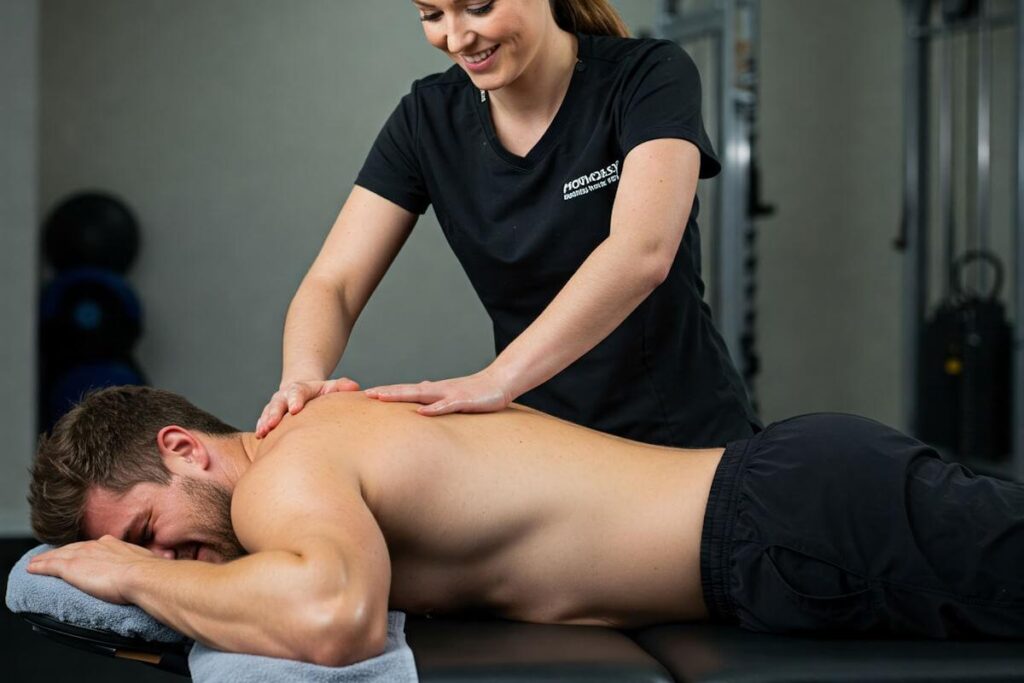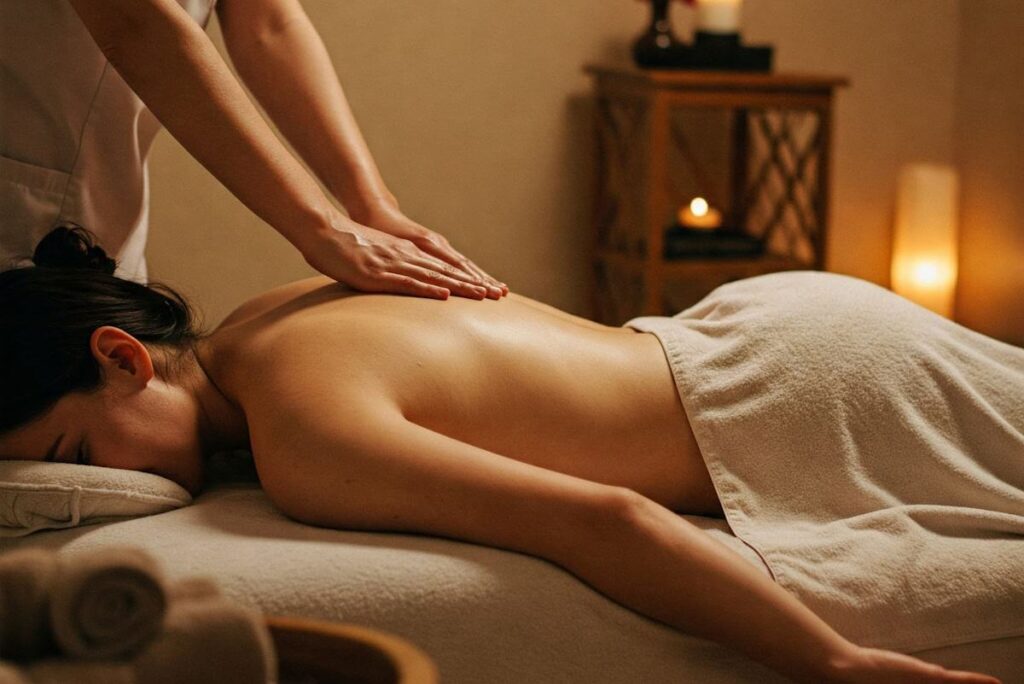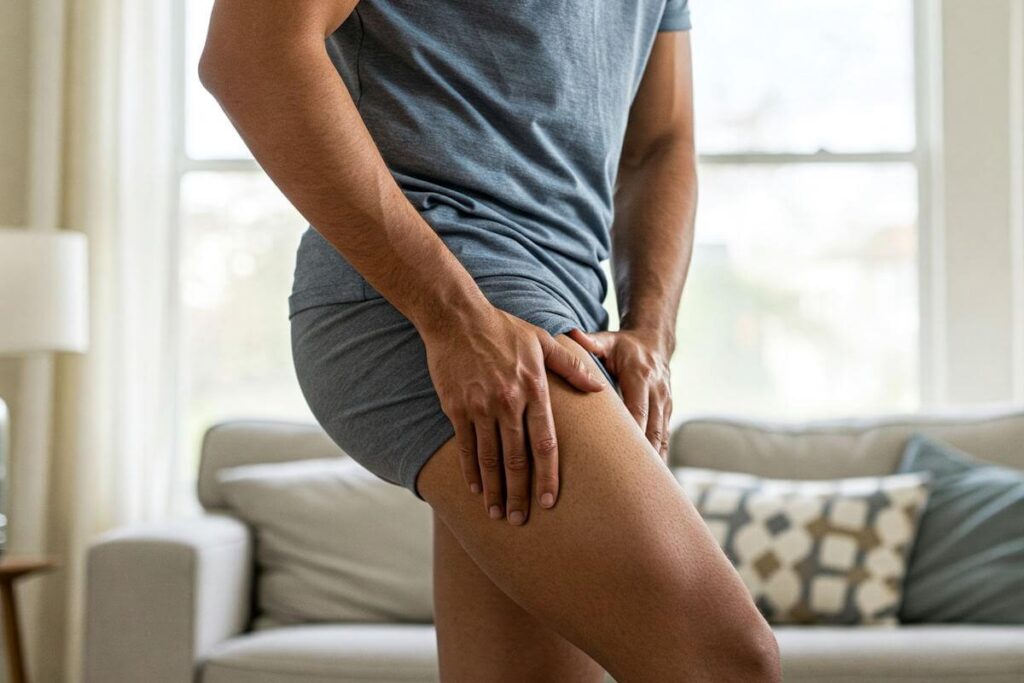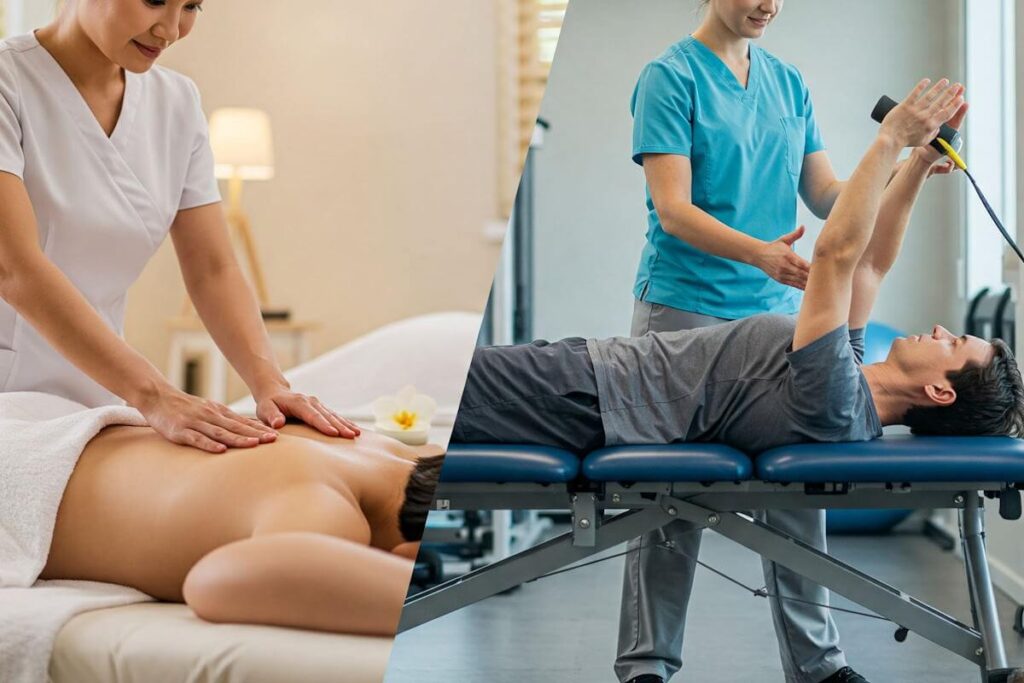Introduction to Massage Therapy in Sports
Massage therapy has emerged as an indispensable aspect of sports medicine, playing a crucial role in enhancing athletic performance and promoting recovery. Athletes across various disciplines have increasingly recognized the benefits of integrating massage into their training routines. Specifically, massage therapy aids in reducing muscle tension, alleviating pain, and improving circulation, which collectively contribute to an athlete’s overall performance. The application of these techniques is tailored to meet the specific needs of the individual athlete, thereby maximizing their potential.
Different types of massage techniques are employed in the context of sports therapy, each serving unique purposes. For instance, Swedish massage is often used for overall relaxation and improving blood flow, while deep tissue massage focuses on alleviating chronic muscle tension and pain. Sports-specific massage techniques are particularly beneficial as they target particular muscle groups and prepare the body for heightened physical demands. In addition, techniques like trigger point therapy stimulate specific areas of discomfort, helping to release tight muscles and improve range of motion.
The increasing inclusion of massage therapy in athletic training regimens is supported by a growing body of research, which underscores its efficacy in promoting recovery and reducing injury risk. Athletes often find that regular massage sessions not only aid in physical recovery but also enhance their mental focus and overall well-being, creating a comprehensive approach to performance enhancement. As the landscape of sports continues to evolve, the integration of massage therapy will likely become more pronounced, emphasizing its value as a holistic tool in an athlete’s arsenal for achieving peak performance.
The Science Behind Massage and Muscle Recovery
Massage therapy has garnered attention in recent years for its profound impact on muscle recovery, particularly among athletes. Scientific studies support the notion that massage facilitates recovery by enhancing blood flow, reducing muscle tension, and alleviating soreness. These physiological effects play a crucial role in improving athletic performance and overall well-being.
One of the primary mechanisms through which massage promotes recovery is by increasing blood circulation. Enhanced blood flow delivers essential nutrients and oxygen to the muscles while simultaneously aiding in the removal of metabolic waste products such as lactic acid. A study published in the journal “Science Translational Medicine” found that massage significantly increased the levels of nitric oxide in the blood, which is instrumental in promoting vasodilation and improving blood flow. This biological response can result in more effective muscle repair and quicker recovery times after intense training or competition.
In addition to boosting circulation, massage therapy is effective at reducing muscle tension. Athletes often experience tightness and stiffness in their muscles due to rigorous physical activity, which can lead to soreness and reduced range of motion. Research has indicated that massage can lower levels of muscle tension by affecting the nervous system and decreasing muscle spindle activity. This reduction in tension not only helps to alleviate discomfort but also enhances flexibility and performance.
Furthermore, the pain-relieving effects of massage are well-documented. A meta-analysis published in “The Clinical Journal of Pain” discovered that massage is effective in significantly reducing delayed onset muscle soreness (DOMS). By alleviating this pain, athletes are better equipped to resume training and maintain their competitive edge. Overall, the physiological effects of massage reinforce its value as a recovery tool, ensuring athletes can continuously perform at their highest level.
Different Types of Massage Techniques for Athletes
Massage therapy is an essential component in the recovery and performance toolkit for athletes. Different techniques are tailored to address specific needs, helping to enhance overall athletic performance. Each massage technique offers unique benefits that can play a crucial role in an athlete’s training regimen.
The Swedish massage is one of the most well-known forms of massage therapy. It employs long, gliding strokes, kneading, and circular movements on the topmost layers of muscle. This technique is particularly beneficial for relaxation and increasing blood circulation, making it ideal for athletes needing a recovery session after intense workouts or competitions. Regular Swedish massages can help reduce muscle tension and promote a sense of well-being.
Deep tissue massage targets deeper layers of muscles and connective tissues. Through the use of slower strokes and deeper pressure, this technique effectively alleviates chronic pain and muscle tightness. Athletes may benefit from deep tissue massage when experiencing persistent soreness or stiffness, as it focuses on specific problem areas, allowing for greater mobility and flexibility over time.
Sports massage is specifically designed for athletes and is often used as a pre-event, during-event, or post-event therapy. This technique incorporates various massage strokes and techniques, including stretching, aimed at preventing injuries and enhancing performance. Pre-event sports massage can warm up muscles, while post-event methods focus on relaxing tight areas and reducing recovery time.
Trigger point therapy is used to relieve specific areas of tension within a muscle. By applying pressure to these trigger points, athletes can alleviate localized pain and improve muscle function. This technique is essential for athletes dealing with repetitive strain and muscle tension caused by rigorous training.
Each massage technique serves a distinct purpose, allowing athletes to choose the most suitable option based on their specific needs and circumstances. Incorporating a variety of these techniques into training can lead to optimal recovery and enhanced performance outcomes.
Timing and Frequency of Massage for Optimal Results
Massage therapy plays a significant role in an athlete’s regimen, facilitating recovery and enhancing overall performance. Determining the ideal timing for massage sessions is crucial in maximizing these benefits. Generally, massages can be strategically scheduled during three key intervals: pre-event, post-event, and during recovery periods. Each of these timings serves different purposes.
Pre-event massages are typically shorter and aim to prepare the athlete’s muscles for physical activity. These sessions focus on warming up the muscles and enhancing blood flow, which helps prevent injuries and improves overall mobility. Athletes often report feeling more alert and ready to compete following a pre-event massage.
Post-event massages are equally important, serving primarily to reduce muscle soreness and promote relaxation. Following intense competitions, these massages focus on flushing out lactic acid and various metabolic waste products from the muscles, aiding in the recovery process. This post-activity approach helps to alleviate tightness and tension built up during performance, enabling a quicker return to training.
Recovery periods also benefit significantly from regular massage sessions. Incorporating massages into recovery schedules can enhance muscle repair, improve flexibility, and decrease overall recovery time. The frequency of these sessions can vary, but athletes are encouraged to assess their individual training programs and listen to their bodies. While some may find relief with weekly treatments, others may increase sessions during peak training weeks or after particularly strenuous competitions.
Adjusting the frequency of massage based on personal response is vital. Athletes should consider factors such as training intensity, injury history, and specific muscle soreness when determining their massage frequency. Overall, integrating a well-timed massage schedule tailored to individual needs can significantly boost recovery and performance outcomes, allowing athletes to reach their full potential.
Massage and Injury Prevention: How It Works
Massage therapy plays a crucial role in injury prevention for athletes by addressing underlying muscle tension and identifying potential areas of concern before they escalate into significant issues. Regular massage can assist in the early detection of muscle imbalances or strains, which are often precursors to more serious injuries. By fostering an environment where these problems can be addressed promptly, athletes can maintain optimal physical health and avoid setbacks in their training regimens.
One of the primary benefits of massage is its ability to improve flexibility. Through targeted manipulation of the muscles and surrounding soft tissues, massage enhances the elasticity of muscles, ligaments, and tendons. Improved flexibility is paramount for athletes, as it allows for a greater range of motion. This increased mobility not only contributes to better overall performance but also significantly reduces the risk of injuries caused by overstretching or muscle strain during physical activities.
Beyond flexibility, massage also enhances blood circulation, which plays an essential role in recovery and injury prevention. Enhanced blood flow ensures that essential nutrients are delivered to the muscles more effectively while also facilitating the removal of metabolic waste. This process contributes to quicker recovery times after workouts and helps maintain the integrity of the muscle fibers, further preventing injuries.
For athletes looking to incorporate massage into their training routine, establishing a regular schedule is vital. This may involve seeking out professional massage therapy sessions or employing self-massage techniques using tools like foam rollers or massage balls. Furthermore, combining massage with stretching and strengthening exercises can create a well-rounded approach to preventive care, allowing athletes to stay in peak condition and continue to perform at their best without the risk of debilitating injuries.
Case Studies: Athletes Who Benefit from Massage Therapy
Massage therapy has become an integral part of many athletes’ training regimens, helping to enhance recovery and performance. Numerous case studies provide evidence of its efficacy across various sports disciplines. For example, professional athletes in sports like soccer, basketball, and track and field consistently report positive outcomes from regular massage sessions.
A notable case is that of an elite long-distance runner who incorporated massage therapy into her training program. She found that regular sessions not only alleviated muscle soreness but also improved her flexibility and range of motion. This runner reported more effective training sessions and a significant reduction in injury occurrences after beginning a structured massage routine. Her experience underscores how massage can play a crucial role in optimizing training and ensuring athletes stay at peak performance levels.
Another compelling example can be seen in a professional basketball player. After suffering from chronic lower back pain, he sought the assistance of a certified massage therapist. The treatment focused on the lumbar region, which was specifically targeted to release tension and improve blood circulation. Following the massage therapy program, he experienced marked relief, allowing him to return to the game without pain. This case highlights how massage therapy can address specific injuries while simultaneously enhancing overall athletic performance.
Moreover, a group of competitive swimmers reported consistently benefiting from massage therapy before and after training sessions. They noted that massage helped to reduce fatigue and improved muscle recovery, which in turn contributed to enhanced performance in competitions. These athletes found that integrating massage therapy into their routine not only aided in physical recovery but also provided a mental relaxation aid, contributing positively to their overall well-being.
These testimonials demonstrate the tangible benefits athletes across various sports can experience through massage therapy. The integration of this treatment stands as an essential component in achieving performance goals and ensuring athletes can train and compete at their best.
Choosing the Right Massage Therapist for Athletes
Selecting an appropriate massage therapist is crucial for athletes aiming to enhance their performance and recovery. The process begins with verifying the therapist’s qualifications. It is essential to look for professionals who possess formal training in sports massage therapy, as this specialty emphasizes techniques tailored to the unique needs of athletes. Certifications from recognized organizations indicate that the therapist has met specific educational and practical standards, thus ensuring a level of expertise in the field.
Experience is another critical factor to consider. It is advisable to choose a therapist who has worked specifically with athletes across various sports disciplines. This experience not only cultivates an understanding of common athletic injuries but also familiarizes the therapist with the physical demands and movement patterns associated with different sports. An experienced sports massage therapist can offer tailored techniques that are beneficial for injury prevention, recovery enhancement, and overall performance improvement.
Moreover, communication plays a vital role in the therapeutic experience. Before commencing treatment, athletes should engage in an open discussion with the therapist regarding their specific athletic needs and preferences. This conversation allows the therapist to customize the massage approach, addressing particular areas of tension or potential issues resulting from training regimens. Furthermore, understanding the athlete’s goals—whether they aim to alleviate muscle soreness, enhance flexibility, or promote relaxation—can significantly influence the choice of techniques employed during the session.
Ultimately, the synergy between the athlete and therapist is paramount. Building a rapport fosters trust and comfort, ensuring that the athlete feels secure in the therapist’s expertise. By considering qualifications, experience, and communication, athletes can find a massage therapist who not only meets their needs but also contributes positively to their athletic journey.
Integrating Massage into a Broader Recovery Strategy
For athletes striving to optimize their performance and accelerate recovery, it is crucial to adopt a holistic approach that encompasses various recovery modalities. Among these, massage therapy has emerged as a significant component. By integrating massage into a broader recovery strategy, athletes can not only enhance their physical performance but also foster overall well-being. This multifaceted approach typically includes aspects such as nutrition, hydration, sleep, and physical therapy, which collectively contribute to an athlete’s recovery process.
Nutrition plays a vital role in an athlete’s recovery strategy. A well-balanced diet rich in essential vitamins, minerals, and macronutrients provides the body with the fuel needed to repair and rebuild muscle tissues post-exercise. Without the right nutritional support, even the most effective massage may have limited benefits. This interplay between nutrition and massage emphasizes the need for athletes to develop a comprehensive recovery plan that addresses all aspects of their health.
Hydration is equally critical, as it directly impacts muscle function and recovery. Insufficient hydration can lead to cramping, fatigue, and slower recovery times. Incorporating massage therapy can further enhance hydration strategies by improving blood circulation, thus promoting better nutrient delivery throughout the body. Additionally, ensuring adequate rest and quality sleep is another pillar of recovery that should not be overlooked. Sleep facilitates muscle recovery and cognitive function, supporting athletes in both physical and mental performance.
Physical therapy may also complement massage therapy by addressing any injuries or biomechanical issues that could hinder performance. Collaborating with a physical therapist allows athletes to assess their needs and integrate targeted therapies into their routines. Overall, the incorporation of massage therapy into a wider recovery strategy not only aids in muscle recovery but also reinforces the significant relationships between various recovery elements, ultimately promoting optimal athletic performance.
The Future of Massage Therapy in Sports Performance
As the sports industry continues to evolve, so too does the field of massage therapy. Athletes, coaches, and healthcare professionals increasingly acknowledge the significance of this practice in enhancing performance and expediting recovery. Looking ahead, several promising developments are expected to transform the landscape of massage therapy in sports.
One notable advancement is the refinement of massage techniques. As research on the physical and psychological effects of massage therapy progresses, practitioners will adopt evidence-based approaches tailored to an athlete’s specific needs. This evolution will likely result in more specialized modalities that focus on different aspects of recovery, such as myofascial release or deep tissue manipulation. Furthermore, customized massage regimens may become standardized as therapists collaborate with sports scientists to optimize treatment plans based on real-time data.
Another significant trend is the integration of technology into massage therapy. As innovations in wearable tech and data analytics continue to emerge, athletes could benefit from devices that monitor their physiological responses during and after massage sessions. High-tech massage tools, such as percussive massagers and portable electrostimulation devices, are increasingly accessible and effective. These advancements will not only enhance the efficacy of treatments but may also streamline the massage process, allowing athletes to receive targeted care with greater efficiency.
Furthermore, ongoing research will uncover new insights into the benefits of massage therapy for athletes. As scientists delve deeper into the biological mechanisms behind muscle recovery and performance enhancement, therapists will better understand how to harness massage as a vital component of athletic training programs. This future emphasis on comprehensive evidence will elevate the status of massage therapy, ensuring it remains an integral part of an athlete’s regimen.




